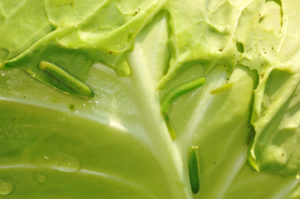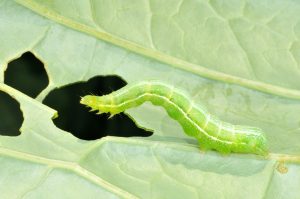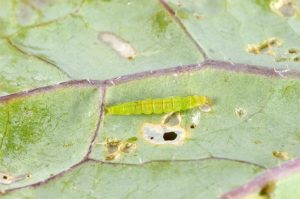There are three important caterpillar pests of crucifers in Indiana, the imported cabbageworm, the cabbage looper, and the diamondback moth. Each of these caterpillars will feed on leaves and heads. All are capable of producing serious damage to most crucifers.
The adult imported cabbageworm is a common white butterfly with black spots on the forewing that can be observed flying early in the spring. The larva is a sluggish green caterpillar (Figure 1), exceeding 1 inch in length at maturity, with a light yellow stripe running down its back. The larvae can consume enough leaf material to reduce plant growth; can feed on the head, making it unmarketable, and can foul the head with excrement.
The cabbage looper does not overwinter in Indiana, but flies into the state each spring from more southerly locations. Larvae are light green with a white stripe along each side of the body. They reach a length of 1 1/2 inches when mature. When they crawl, the central region of the body is pushed up into a hump, thus the name looper (Figure 2). Loopers tend to be more of a later season problem, with the timing of their arrival here depending on when conditions are right for them to fly or be blown up from the South.
The adult stage of the diamondback moth is a very small (1/3 – 1/2 inch), slender moth that, with its wings folded, appears to have a row of three diamond-shaped yellow spots in the middle of the back. The larvae are much smaller than those of the other two caterpillar species, reaching a maximum length of 1/3 inch (Figure 3). They can also be identified because of their vigorous wriggling behavior or by their dropping from the plant by a silken thread when disturbed. The larvae are pale greenish-yellow and pointed at both ends. The larvae can complete development in as little as 10 days when temperatures are warm.
All three of these caterpillar species cause similar feeding damage. However, each cabbage looper larva will consume more foliage than an imported cabbageworm and much more than a diamondback moth larva. Cabbage is fairly tolerant of leaf feeding, but care must be taken that the caterpillars do not feed on the heart leaves, which could prevent head formation, or within the head, which could render the head unmarketable. Cauliflower and broccoli can tolerate substantial feeding on the leaves, but any feeding on the heads must be avoided. Radishes and turnips grown for roots can tolerate significant feeding damage. However, turnips grown for greens, collard, and mustard must be well protected, because the leaves are the marketable portion of the crop.
Organic methods for controlling caterpillars on crucifiers include Bt insecticides (Agree, Biobit, Dipel, Javelin, Lepinox, Xentari) or Entrust. These insecticides provide good control of all three species.
Conventional insecticides that will provide good to excellent control of these caterpillars include Ambush®, Asana®, Avaunt, Baythroid®, Brigade®, Confirm®, Coragen®, Exirel®, Intrepid®, Larvin®, Mustang Maxx®, Proclaim®, Radiant®, Rimon®, and Warrior®.


